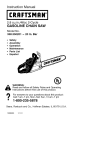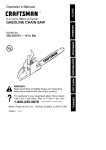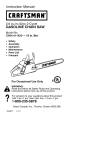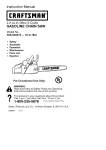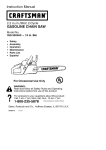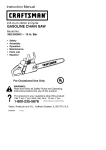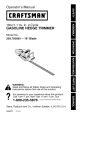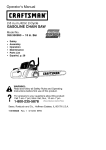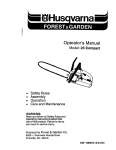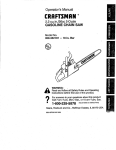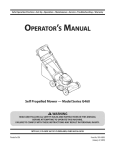Download Craftsman 358.350380 Instruction manual
Transcript
Instruction Manual I CRRFTSMRN°I 2.6 cu.in./42cc GASOLINE Model No. 358.350380 Q Safety Q Assembly Operation Maintenance Q Q Q 2-Cycle CHAIN SAW - 18 in. Bar Parts List Q Espa_ol _ _ For Occasional Use Only WARNING: Read and follow all Safety Rules and Operating Instructions before first use of this product. For answers Call 7 am-7 to your questions about this product: pm, Mon-Sat; Sun, 10 am-7 pm 1-800-235-5878 Sears, Roebuck 530086518 7/19/01 and Co., Hoffman _Hours listed are Central Time) Estates, IL 60179 U.S.A. Warranty Safety Rules Assembly Operation Maintenance Service and Adjustments 2 2 6 7 13 16 Storage Troubleshooting Table Emissions Statement Parts List Spanish Parts & Ordering 18 19 20 22 25 Back Cover FULL ONE YEAR WARRANTY ON CRAFTSMAN _ GAS CHAIN SAW For one year from the date of purchase, when this Craftsman Gas Chain Saw is maintained, lubricated and tuned up according to the instruction manual, Sears will repair, free of charge, any defect in material or workmanship. This warranty excludes the bar, chain, spark plug and air filter, which are expendable parts, and become worn during normal use. If this Gas Chain Saw is used for commercial or rental purposes, this warranty applies for 30 days from the date of purchase. WARRANTY SERVICE IS AVAILABLE BY RETURNING THIS CHAIN SAW TO THE NEAREST SEARS STORE OR SERVICE CENTER IN THE UNITED STATES. This warranty gives you specific legal rights, and you may also have other rights which vary from state to state. Sears, Roebuck and Co., D/817 WA, Hoffman Estates, IL 60179 WARNING: Always disconnect spark plug wire when making repairs except for carburetor adjustments. Because a chain saw is a high-speed woodcutting tool, special precautions must be observed to reduce risk of accidents. Careless or improper use of this tool can cause serious injury. PLAN AHEAD • Restrict the use of your saw to adult users who understand and can follow the safety rules, precautions, and operating instructions found in this manual. Hearing Protection ' _- I'_'_; Snug Fitting ..... _ Clothing Safety Shoes ..... Safety Hat Eye Protection Heavy Duty Gloves f \ • • • • Safety Chaps \4 i.IIi • Wear protective gear. Always use steel-toed safety footwear with nonslip soles; snug-fitting clothing; heavy-duty, non-slip gloves; eye pro- • tection such as non-fogging, vented goggles or face screen; an approved safety hard hat; and sound barriers (ear plugs or mufflers) to protect your hearing. Regular users should have hearing checked regularly as chain saw noise can damage hearing. Secure hair above shoulder length. Do not wear loose clothing or jewelry; they can get caught in moving parts. Keep all parts of your body away from the chain when the engine is running. Keep children, bystanders, and animals at least 30 feet (10 meters) away from the work area when starting and using the saw. Do not handle or operate a chain saw when you are fatigued, ill, or upset, or if you have taken alcohol, drugs, or medication. You must be in good physical condition and mentally alert. If you have any condition that might be aggravated by strenuous work, check with doctor before operating. Do not start cutting until you have a clear work area, secure footing, and especially if you are felling a tree, a retreat path. OPERATE YOUR SAW SAFELY • Donotoperate withonehand. Seriousinjury totheoperator, helpers, or bystanders mayresult fromonehanded operation. Achainsawisintended fortwo-handed use. • Operate thechain sawonlyinawellventilated outdoor area. • Donotoperate sawfromaladder or inatree. • Make surethechain willnotmake contact withanyobject whilestarting theengine. Never try to start the saw when the guide bar is in a cut. • Do not put pressure on the saw, especially at the end of the cut. Doing so can cause you to lose control when the cut is completed. • Stop engine before setting saw down. • Hand carry saw only when engine is stopped. Carry with muffler away from body; guide bar & chain projecting behind you; guide bar preferably covered with a scabbard. • Do not operate a chain saw that is damaged, improperly adjusted, or not completely and securely assembled. Always replace bar, chain, hand guard, chain brake, or other parts immediately if they become damaged, broken, or are otherwise removed. MAINTAIN YOUR SAW IN GOOD WORKING ORDER • Have all chain saw service performed by a qualified service dealer except the items listed in the MAINTENANCE section of this manual. • Make certain the saw chain stops moving when the throttle trigger is released. For correction, refer to CARBURETOR ADJUSTMENTS. • Keep the handles dry, clean, and free from oil or fuel mixture. • Keep caps and fasteners securely tightened. • Nonconforming replacement components or the removal of safety devices may cause damage to the unit and possible injury to the operator or bystanders. Use only Craftsman accessories and replacement parts as recommended. Never modify your saw. • Maintain chain saw with care. • Keep unit sharp and clean for better and safer performance. • Follow instructions for lubricating and changing accessories. • Check for damaged parts. Before further use of the chain saw, a guard or other part that is damaged should be carefully checked to determine that it will operate properly and perform its intended function. Check for alignment of moving parts, binding of moving parts, breakage of parts, mounting and any other conditions that may affect its operation. A guard or other part that is damaged should be properly repaired or replaced by a Sears Service Center unless otherwise indicated elsewhere in the instruction manual. • When not in use, chain saws should be stored in a dry, high or locked-up place out of the reach of children. • When storing saw, use a scabbard or carrying case. HANDLE FUEL WITH CAUTION • Do not smoke while handling fuel or while operating the saw. • Eliminate all sources of sparks or flame in areas where fuel is mixed or poured. • Mix and pour fuel in an outdoor area and use an approved, marked container for all fuel purposes. Wipe up all fuel spills before starting saw. • Move at least 10 feet (3 meters) from fueling site before starting. • Turn the engine off and let saw cool in a non-combustible area, not on dry leaves, straw, paper, etc. Slowly remove fuel cap and refuel unit. • Store the unit and fuel in a cool, dry well ventilated space where fuel vapors cannot reach sparks or open flames from water heaters, electric motors or switches, furnaces, etc. GUARD AGAINST KICKBACK Follow all safety rules to help avoid kickback and other forces which can result in serious injury. _'_ ._,:f.¢' _t.._ <_2_ f _;_ Kickback Path Avoid Obstructions Clear The Working Area Z_ LI_ WARNING: Avoid kickback which can result in serious injury. Kickback is the backward, upward or sudden forward motion of the guide bar occurring when the saw chain near the upper tip of the guide bar contacts any object such as a log or branch, or when the wood closes in and pinches the saw chain in the cut. Contacting a foreign object in the wood can also result in loss of chain saw control. • Rotational Kickback can occur when the moving chain contacts an object at the upper tip of the guide bar. This contact can cause the chain to dig into the object, which stops the chain for an instant. The result is a lightning fast, reverse reaction which kicks the guide bar up and back toward the operator. • Pinch-Kickback can occur when the the wood closes in and pinches the moving saw chain in the cut along the top of the guide bar and the saw chain is suddenly stopped. This sudden stopping of the chain results in a reversal of the chain force used to cut wood and causes the saw to move in the opposite direction of the chain rotation. The saw is driven straight back toward the operator. • Pull-In can occur when the moving chain contacts a foreign object in the wood in the cut along the bottom of the guide bar and the saw chain is suddenly stopped. This sudden stopping pulls the saw forward and away from the operator and could easily cause the operator to lose control of the saw. REDUCE THE CHANCE OF KICKBACK • Recognize that kickback can happen. With a basic understanding of kickback, you can reduce the element of surprise which contributes to accidents. • Never let the moving chain contact any object at the tip of the guide bar. • Keep working area free from obstructions such as other trees, branches, rocks, fences, stumps, etc. Eliminate or avoid any obstruction that your saw chain could hit while cutting. • When cutting a branch, do not let the guide bar contact another branch or other objects around it. • Keep saw chain sharp and properly tensioned. A loose or dull chain can increase the chance of kickback. Follow manufacturer's chain sharpening and maintenance instructions. Check tension at regular intervals, but never with engine running. Make sure chain brake nuts are securely tightened. • Begin and continue cutting at full speed. If the chain is moving at a slower speed, there is greater chance of kickback occurring. • Use extreme caution when reentering a cut. • Do not attempt cuts starting with the tip of the bar (plunge cuts). • Watch for shifting logs or other forces that could close a cut and pinch or fall into chain. • Use the specified Reduced-Kickback Guide Bar and Low-Kickback Chain. Avoid Pinch-Kickback: • Be extremely aware of situations or obstructions that can cause material to pinch the top of or otherwise stop the chain. • Do not cut more than one log at a time. • Do not twist saw as bar is withdrawn from an undercut when bucking. Avoid Pull-In: • Always begin cutting with the engine at full speed and the saw housing against wood. • Use wedges made of plastic or wood. Never use metal to hold the cut open. MAINTAIN CONTROL Stand to the left of the saw underside Thumb on t \[ • \\ Elbow locked Never reverse hand positions • A good, firm grip on the saw with both hands will help you maintain control. Don't let go. Grip the rear handle with your right hand whether you are right or left handed. Wrap the fingers of your left hand over and around the front handlebar, and your left thumb under the front handlebar. Keep your left arm straight with the elbow locked. • Position your left hand on the front handlebar so it is in a straight line with your right hand on the rear handle when making bucking cuts. Stand slightly to the left side of the saw to keep yourbody frombeing inadirect CHAIN BRAKE linewiththecutting chain. • Chain Brake: designed to stop the chain in the event of kickback. • Stand withyourweight evenly balanced onboth feet. • Donotoverreach. Youcould bedrawn m_WARNINu: WE DO NOT REPorthrown offbalance andlosecontrol. RESENT AND YOU SHOULD NOT AS• Donotcutabove shoulder height. Itis SUME THAT THE CHAIN BRAKE WILL difficult tomaintain control ofsaw PROTECT YOU IN THE EVENT OF A above shoulder height. Kickback is a lightning fast KICKBACK SAFETY FEATURES KICKBACK. action which throws the bar and rotat,_ WARNING: The following features are included on your saw to help reduce hazard of kickback; however, such features will not totally eliminate this danger. Do not rely only on safety devices. Follow all safety rules to help avoid kickback and other forces which can result in serious injury, • Front Hand Guard: designed to reduce the chance of your left hand contacting the chain if your hand slips off the front handlebar. • Position of front and rear handlebars: designed with distance between handles and "in-line" with each other. The spread and "in-line" position of the hands provided by this design work together to give balance and resistance in controlling the pivot of the saw back toward the operator if kickback occurs. • Reduced-Kickback Guide Bar: designed with a small radius tip which reduces the size of the kickback danger zone on the bar tip. This type bar has been demonstrated to significantly reduce the number and seriousness of kickbacks when tested in accordance with ANSI B175.1. Tip Guide Bar _,_._, Small Radius Large Radius [ Tip Guide Bar • Low-Kickback Chain: "/_' has met kick- back performance requirements when tested on a representative sample of chain saws below 3.8 cubic inch displacement specified in ANSI B175.1. Low-Kickback Chain Contoured Depth Gauge ......... Elongated Guard Link force and allows wood deflectsto gradually kickback ride into Cutter ing chain back and up toward the operator. Kickback can be caused by allowing contact of the bar tip in the danger zone with any hard object. Kickback can also be caused by pinching the saw chain along the top of the guide bar. This action may push the guide bar rapidly back toward the operator. Either of these events may cause you to lose control of the saw which could result in serious injury or even death. DO NOT RELY UPON ANY OF THE DEVICES BUILT INTO YOUR SAW. YOU SHOULD USE THE SAW PROPERLY AND CAREFULLY TO AVOID KICKBACK. Reduced-kickback guide bars and low-kickback saw chains reduce the chance and magnitude of kickback and are recommended. Your saw has a low kickback chain and bar as original equipment. Repairs on a chain brake should be made by an authorized Sears Service Center. Take your unit to the place of purchase or to your nearest Sears Service Center. • Tip contact in some cases may cause a lightning fast reverse REACTION, kicking guide bar up and back toward operator. • Pinching the saw chain along the top of the guide bar may push the guide bar rapidly back toward the operator. • Either of these reactions may cause you to lose control of the saw which could result in serious injury. Do not rely exclusively upon safety devices built into your saw. SAFETY NOTICE: Exposure to vibrations through prolonged use of gasoline powered hand tools could cause blood vessel or nerve damage in the fingers, hands, and joints of people prone to circulation disorders or abnormal swelling. Prolonged use in cold weather has been linked to blood vessel damage in otherwise healthy people. If symptoms occur such as numbness, pain, loss of strength, change in skin color or texture, or loss of feeling in the fingers, hands, or joints, discontinue theuseofthistool estlandandthestates ofCalifornia, Idaandseekmedical attention. Ananti-vi- ho,Maine, Minnesota, NewJersey, bration system does notguarantee the Oregon, andWashington require bylaw avoidance ofthese problems. Users that m any internal combustion engines whooperate power toolsonacontinual beequipped withaspark arresting andregular basis must closely monitor screen. Ifyou operate achain sawina theirphysical condition andtheconditionstate o rlocale where such regulations ofthistool. exist, youarelegally responsible for CHAIN BRAKE: Ifthissawistobe maintaining theoperating condition of used forcommercial logging, achain these p arts. Failure todosoisaviolabrake isrequired andshall notberetionofthelaw.Refer toCustomer Removed orotherwise disabled tocomply sponsibilities chart intheMAINTENANCE withFederal OSHA Regulations for section. Commercial Logging. STANDARDS: Thischain sawislisted SPARK ARRESTING SCREEN: Your byUnderwriters Laboratories, Inc.inacwithAmerican National Stansawisequipped withatemperature lim- cordance forGasoline-Powered Chain iting muffler andspark arresting screen dards which meets therequirements ofCalifor- Saws Safety Requirements (ANSI niaCodes 4442 and4443. AllU.S. for- B175.1-2000). ,_ WARNING: Before using chain saw, ensure all fasteners are secure. CARTON CONTENTS Check carton contents against the following list. Model 358,350380 • Chain Saw (fully assembled) • Bar tool • 2-cycle engine oil • Carrying case • Extra chain Examine parts for damage. Do not use damaged parts. If you need assistance or find that parts are missing or damaged, please call 1-800-235-5878. NOTE: It is normal to hear the fuel filter rattle in an empty fuel tank. Your unit has been factory tested and the carburetor precisely adjusted. As a result you may smell gasoline or find a drop of oil/fuel residue on the muffler when you unpack the unit. ASSEMBLY Your saw is fully assembled; assembly is necessary. no KNOW YOUR SAW READ THIS INSTRUCTION MANUAL AND SAFETY RULES BEFORE OPERATING YOUR CHAIN SAW. Compare the illustrations with your unit to familiarize yourself with the location of the various controls and adjustments. Save this manual for future reference. Chain Adjustment Tool (Bar Tool) Front Hand Guard ''_ r_ _/,_ ILl, I_ Handle,Front Starter Rope ON/STOP Switch Muffler [ __ Bar Oil Fill Cap Fast Idle _ Cylinder Throttle Lock ,.t_/Cover /q Lockout / ,.--L- Rea_lle_@ Throttle Trigger _ Choke Knob Chain Brake _ r Housing Pr_ber Fuel Mix Fill Cap Adjusting _. ,u2v 2 Screw / /- _i'___i Chain Brake Chain Nuts Catcher ON/STOP SWITCH The ON/STOP SWITCH is used to stop the engine. THROTTLE TRIGGER The THROTTLE TRIGGER controls engine speed. THROTTLE LOCKOUT The THROTTLE LOCKOUT must be pressed before you can squeeze the throttle trigger. This feature prevents you from accidentally squeezing the trigger. FAST IDLE LOCK The FAST IDLE LOCK holds the throttle trigger in the starting position. Activate the fast idle lock by pressing the throttle lockout and squeezing the throttle trigger. With the throttle trigger squeezed, press the fast idle lock. Release the throttle lockout and trigger while holding the fast idle lock button. Chain. ulrec_ton , Travel Guide Bar CHOKE KNOB The CHOKE KNOB activates the choke to provide additional fuel to the engine during cold starting. PRIMER BULB The PRIMER BULB circulates fuel to the carburetor to provide quicker starting. CHAIN BRAKE The CHAIN BRAKE is a device designed to stop the chain if kickback occurs. The chain brake activates automatically in the event of kickback. The chain brake activates manually if the front hand guard is pushed forward. The chain brake is disengaged by pulling the front hand guard back toward the front handle as far as possible. CHAIN TENSION It is normal for a new chain to stretch during first 30 minutes of operation. You should check your chain tension frequently. See CHAIN TENSION under the SERVICE AND ADJUSTMENTS section. 7 Once oilisadded tothegasoline, m_WARNING: Muffler isveryhot shake container momentarily toassure during andafteruse.Donottouch the thefuelisthoroughly mixed. Almuffler orallow combustible material that ways readandfollow thesafety rules suchasdrygrass orfueltodoso. relating tofuelbefore fueling yourunit. BEFORE STARTING ENGINE IMPORTANT Experience indicates thatalcohol _WARNING:Besuretoread the blended fuels(called gasohol orusing ormethanol) canattract moisfuelhandling information inthesafety ethanol leads toseparation and rules section ofthismanual before you turewhich formation ofacids during storage. Acidic begin. Ifyoudonotunderstand the gascandamage thefuelsystem ofan fuelhandling information donotatwhile instorage. Toavoid engine tempt tofuelyourunit.Seek helpfrom engine thefuelsystem should be someone thatdoesunderstand thein- problems, before storage for30days or formation orcallthecustomer assis- emptied Drain thegastank, start theentance helplineat1-800-235-5878. longer. gineandletitrununtil thefuellinesand GUIDE BARANDCHAIN OIL areempty. Use fresh fuel Thebarandchain require lubrication. carburetor next season. See STORAGE instructions Thechain oilerprovides continuous foradditional information. lubrication tothechainandguide bar. Never use engine orcarburetor cleanBesuretofillthebaroiltankwhen you inthefueltankorpermafillthefueltank(Capacity =6.8fl.oz.). erproducts damage mayoccur. Lack ofoilwillquickly ruinthebarand nent theSTORAGE section foradditionchain.Toolittleoilwillcause overheat-See alinformation. ingshown bysmoke coming fromthe BRAKE chain and/or discoloration ofthebar. CHAIN chainbrake isdisengaged by Formaximum guide barandchain life, Ensure thefronthand guard backtowerecommend youuseCraftsman pulling ward thefronthandle asfarasposchain sawbaroil.IfCraftsman baroil Thechainbrake must bedisenisnotavailable, youmayuseagood sible. before cutting withthesaw. grade SAE30oiluntilyouareableto gaged obtain Craftsman brand. Theoiloutput ,e_ WARNING: The chain must not isautomatically metered during operation.Your sawwilluseapproximatelymove when the engine runs at idle onetankofbaroilforevery tankoffuel speed. If the chain moves at idle refer to CARBURETOR ADJUSTmix.Always fillthebaroiltankwhen speed, MENT within this manual. Avoid conyoufillthefueltank. tact with the muffler. A hot muffler can FUELING ENGINE cause serious burns. STOPPING YOUR ENGINE _WARNING:Remove fuelcap • Move ON/STOP switch to the STOP slowly whenrefueling. position. Thisengine iscertified tooperate on STARTING POSITION unleaded gasoline. Before operation, start the engine, hold the saw gasoline must bemixed withagood • To firmly on the ground as illustrated. quality 2-cycle air-cooled engine oil. Make sure the chain is free to turn Werecommend Craftsman brand oil. without contacting any object. Mixgasoline andoilataratioof40:1. Starter Rope Handle A40:1ratioisobtained bymixing 3.2 ounces ofoilwith1gallon ofunleaded gasoline. Included withthissawisa 3.2ounce container ofCraftsman brand oil.Pour theentire contents of thiscontainer into1gallon ofgasoline toachieve theproper fuelmixture. DONOT USE automotive oilorboatoil. These oilswillcause engine damage. When mixing fuelfollow theinstructionsprinted ontheoilcontainer. IMPORTANT POINTS TO REMEMBER When pulling the starter rope, do not use the full extent of the rope as this can cause the rope to break. Do not let starter rope snap back. Hold the handle and let the rope rewind slowly. NOTE: DO NOT attempt to cut material with the fast idle lock button in the locked position. STARTING A COLD ENGINE (or a warm engine after running out of fuel) 1. Move ON/STOP switch to ON position. 2. Pull choke knob out to the full extent. 3. Slowly press the primer bulb 6 times. Primer Bulb Switch Cho e,i :i DIFFICULT STARTING (or starting a flooded engine) The engine may be flooded if it has not started after 10 pulls. Flooded engines can be cleared of excess fuel by following the warm engine starting procedure listed above. Insure the ON/STOP switch is in the ON position. Starting could require many pulls depending on how badly unit is flooded. If engine still fails to start, refer to the TROUBLESHOOTING TABLE or call 1-800-235-5878. CHAIN BRAKE A _1_ WARNING: If the brake band is worn too thin it may break when the chain brake is triggered. With a broken brake band, the chain brake will not stop the chain. The chain brake must be replaced if any part is worn to less than 1/32" thick. Repairs on a chain brake should be made by your Sears Service Center. Take your unit to the place of purchase or to the nearest Sears Service Center. • This saw is equipped with a chain brake. The brake is designed to stop the chain if kickback occurs. • The inertia-activated chain brake is activated if the front hand guard is pushed forward, either manually (by hand) or automatically (by sudden movement). • If the brake is already activated, it is disengaged by pulling the front hand guard back toward the front handle as far as possible. • When cutting with the saw, the chain brake must be disengaged. CHOK i POSmONS Knob L_.l Off 4. -_', Full Squeeze and hold throttle trigger. With thumb press fast idle lock down; then release throttle trigger. 5. Sharply pull the starter rope handle 5 times with your right hand. Then, proceed to the next step. NOTE: If the engine sounds as if it is trying to start before the 5th pull, stop pulling and immediately proceed to the next step. 6. Fully push in choke knob (to the OFF position); pull the starter rope until the engine starts. 7. Allow the engine to run for approximately 5 seconds. Then, squeeze and release the throttle trigger to allow engine to return to idle speed. STARTING A WARM ENGINE 1. Fully push in choke knob (to the OFF position). 2. Move ON/STOP switch to ON position. 3. Slowly press primer bulb 6 times. 4. Squeeze and hold throttle trigger. With thumb press fast idle lock down; then release throttle trigger. 5. Sharply pull starter rope with your right hand until the engine starts. 6. Squeeze and release the throttle trigger to return engine to idle speed. Disengaged _ Braking function control CAUTION: The chain brake must be checked several times daily. The engine must be running when performing this procedure. This is the only instance when the saw should be placed on the ground with the engine running. Place the saw on firm ground. Grip the rear handle with your right hand and the front handle with your left hand. Apply full throttle by fully depressing the throttle trigger. Activate the chain brake by turning your left wrist against thehand guard without releasing your griparound thefront handle. Thechain should stopimmediately. Inertia activating function control _WARNING: When performing the following procedure, the engine must be turned off. Grip the rear handle with your right hand and the front handle with your left hand. Hold the chain saw approximately 14" (35 cm) above a stump or other wooden surface. Release your grip on the front handle and let the tip of the guide bar fall forward and contact the stump. When the tip of the bar hits the stump, the brake should activate. OPERATING TIPS • Check chain tension before first use and after 1 minute of operation. See CHAIN TENSION in the MAINTENANCE section. • Cut wood only. Do not cut metal, plastics, masonry, non-wood building materials, etc. • Stop the saw if the chain strikes a foreign object. Inspect the saw and repair parts as necessary. • Keep the chain out of dirt and sand. Even a small amount of dirt will quickly dull a chain and increase the possibility of kickback. • Practice cutting a few small logs using the following steps. This will help you get the "feel" of using your saw before you begin a major sawing operation. • Squeeze the throttle trigger and allow the engine to reach full speed before cutting. • Begin cutting with the saw frame against the log. • Keep the engine at full speed the entire time you are cutting. • Allow the chain to cut for you. Exert only light downward pressure. • Release the throttle trigger as soon as the cut is completed, allowing the engine to idle. If you run the saw at full throttle without a cutting load, unnecessary wear can occur. • To avoid losing control when cut is complete, do not put pressure on saw at end of cut. • Stop engine before setting saw down. TREE ,_ FELLING WARNING: TECHNIQUES Check for broken or dead branches which can fall while cutting causing serious injury. Do not cut near buildings or electrical wires if you do not know the direction of tree fall, nor cut at night since you will not be able to see well, nor during bad weather such as rain, snow, or strong winds, etc. • Carefully plan your sawing operation in advance. • Clear the work area. You need a clear area all around the tree so you can have secure footing. • The chain saw operator should keep on the uphill side of the terrain as the tree is likely to roll or slide downhill after it is felled. • Study the natural conditions that can cause the tree to fall in a particular direction. These conditions include: • The wind direction and speed. • The lean ofthe tree. The lean of a tree might not be apparent due to uneven or sloping terrain. Use a plumb or level to determine the direction of tree lean. • Weight and branches on one side. • Surrounding trees and obstacles. • Look for decay and rot. If the trunk is rotted, it can snap and fall toward the operator. • Make sure there is enough room for the tree to fall. Maintain a distance of 2-1/2 tree lengths from the nearest person or other objects. Engine noise can drown out a warning call. • Remove dirt, stones, loose bark, nails, staples, and wire from the tree where cuts are to be made. _l_q_z ' I' Plan a clear retreat path __,_--_- Direction of fall 45" /_ FELLING LARGE TREES (6 inches in diameter or larger) The notch method is used to fell large trees. A notch is cut on the side of the tree in the desired direction of fall. After a felling cut is made on the opposite side of tree, the tree will tend to fall in the direction of the notch. 10 NOTE: Iftreehaslarge buttress roots, remove thembefore making thenotch. Ifusing sawtoremove buttress roots, keep sawchain fromcontacting ground toprevent dulling ofthechain. NOTCH CUT ANDFELLING TREE • Make notch cutbycutting thetopof thenotch first.Cutthrough 1/3ofthe diameter ofthetree.Nextcomplete thenotch bycutting thebottom. See illustration. Once thenotch iscut,remove thewedge ofwoodfromtree. Felling cuthere First cut I 2/ Notch ,,. tj "- A- "- z _!f Second cutSf / \ _ge • After removing the wood from the notch, make the felling cut on the opposite side of the notch. This is done by making a cut about two inches higher than the center of the notch. This will leave enough uncut wood between the felling cut and the notch to form a hinge. This hinge will help prevent the tree from falling in the wrong direction. Hinge holds tree on stump and helps control fall Opening of felling cut Closing of notch NOTE: Before felling cut is complete, use wedges to open the cut when necessary to control the direction of fall. To avoid kickback and chain damage, use wood or plastic wedges, but never steel or iron wedges. • Be alert to signs that the tree is ready to fall: cracking sounds, widening of the felling cut, or movement in the upper branches. • As tree starts to fall, stop saw, put it down, and get away quickly on your planned retreat path. • DO NOT use your saw to cut down a partially fallen tree. Be extremely cautious with partially fallen trees that may be poorly supported. When a tree doesn't fall completely, set the saw aside and pull down the tree with a cable winch, block and tackle, or tractor. CUTTING A FALLEN TREE (BUCKING) Bucking is the term used for cutting a fallen tree to the desired log size. ,_k WARNING: Do not stand on the log being cut. Any portion can roll causing loss of footing and control. Do not stand downhill of the log being cut. IMPORTANT POINTS • Cut only one log at a time. • Cut shattered wood very carefully; sharp pieces of wood could be flung toward operator. • Use a sawhorse to cut small logs. Never allow another person to hold the log while cutting and never hold the log with your leg or foot. • Do not cut in an area where logs, limbs, and roots are tangled. Drag logs into a clear area before cutting them by pulling out exposed and cleared logs first. BUCKING TECHNIQUES A m_, WAR NI N G: If saw becomes pinched or hung in a log, don't try to force it out. You can lose control of the saw resulting in injury and/or damage to the saw. Stop the saw, drive a wedge of plastic or wood into the cut until the saw can be removed easily. Restart saw and carefully reenter the cut. Do not use a metal wedge. Do not attempt to restart your saw when it is pinched or hung in a log. Use a wedge to remove pinched saw Turn saw OFF and use a plastic or wooden wedge to force cut open. Overcutting begins on the top side of the log with the bottom of the saw against the log. When overcutting use light downward pressure. x_Overcutting .4& _( Undercutting % Undercutting involves cutting on the underside of the log with top of saw against the log. When undercutting 11 uselightupward pressure. Holdsaw Using a support stand firmly andmaintain control. Thesaw willtendtopush backtoward you. / _nd _WARNING:Never turnsawupsidedown toundercut. Thesawcannotbecontrolled inthisposition. _--d4__------'zylst Always make yourfirstcutonthecompression sideofthelog.Thecompressionsideofthelogiswhere thepres1st Cut .. sureofthelog's weight isconcentrated. First cutoncompression side oflog L 2 nd AND PRUNING _WARNING: First cutoncompression side oflog BUCKING WITHOUT A SUPPORT • Overcut through 1/3 of the diameter of the log. • Roll the log over and finish with a second overcut. • Watch for logs with a compression side to prevent the saw from pinching. See illustrations above for cutting logs with a compression side. BUCKING USING A LOG OR SUPPORT STAND • Remember your first cut is always on the compression side of the log. (Refer to the illustrations below for your first and second cut). • Your first cut should extend 1/3 of the diameter of the log. • Finish with your second cut. Using a log for support 2nd Cut % . "\ ._ 1 st Cut _ -- -J- _ 2nd Cut -:":':-'___ _ _ 1 st Cut Cut Cut ZZ LIMBING Second cut Cut Be alert for and guard against kickback. Do not allow the moving chain to contact any other branches or objects at the nose of the guide bar when limbing or pruning. Allowing such contact can result in serious injury. ,_WARNING: Never climb into a tree to limb or prune. Do not stand on ladders, platforms, a log, or in any position which can cause you to lose your balance or control of the saw. IMPORTANT POINTS • Watch out for springpoles. Springpoles are small size limbs which can whip toward you, or pull you off balance. Use extreme caution when cutting small size limbs. • Be alert for springback from any branches that are bent or under pressure. Avoid being struck by the branch or the saw when the tension in the wood fibers is released. • Frequently clear branches out of the way to avoid tripping over them. LIMBING • Limb a tree only after it is cut down. • Leave the larger limbs underneath the felled tree to support the tree as you work. • Start at the base of the felled tree and work toward the top, cutting branches and limbs. Remove small limbs with one cut. • Keep the tree between you and the chain. • Remove larger branches with the cutting techniques described in BUCKING WITHOUT A SUPPORT. 12 • Always useanovercut tocutsmall • Finish thepruning operation byusing andfreely hanging limbs. Undercut- anovercut sothatthestump ofthe limb)rotrudes 1to2 inches fromthe tingcouldcause limbs tofalland trunkofthetree. pinch thesaw. PRUNING Sectln. dcut _WARNIN_I:Limit pruning tolimbs shoulder height orbelow. Donotcutif branches arehigher thanyourshoulder.Getaprofessional todothejob. Sto &y • Make yourfirstcut1/3oftheway through thebottom ofthelimb.This cutwillmake thelimbsagsothatit /_ Third cut lto2 fallseasily onthesecond cut. • Nextmake thesecond cutanoverI \ inches from trunk of tree cutallthewaythrough thelimb. WARNING: Disconnect the spark plug before performing except for carburetor adjustments. CUSTOMER maintenance RESPONSIBILITIES Fill in dates as you complete regular service Check for damaged/worn Before Use After Use Every i 2E5v_y ilYearly i Service 5 hrs. i Dates parts Check for loose fasteners/parts Check chain tension Check chain sharpness Check guide bar Check fuel mixture level Check guide bar and chain oil Lubricate Inspect bar sprocket _ hole and clean unit & decals Check chain brake i Clean guide bar groove Clean air filter Clean/inspect muffler and spark arresting screen Replace i i spark plug and fuel filter i GENERAL RECOMMENDATIONS The warranty on this unit does not cover items that have been subjected to operator abuse or negligence. To receive full value from the warranty, the operator must maintain unit as instructed in this manual. Various adjustments will need to be made periodically to properly maintain your unit. • Once a year, replace the spark plug, air filter element, and check guide bar and chain for wear. A new spark plug and air filter element assures proper air-fuel mixture and helps your engine run better and last longer. CHECK FOR DAMAGED OR WORN PARTS Contact Sears Service Center for replacement of damaged or worn parts. NOTE: It is normal for a small amount of oil to appear under the saw after en13 ginestops. Donotconfuse thiswitha leaking oiltank. • ON/STOP Switch - Ensure ON/STOP switch functions properly bymoving theswitch totheSTOP position. Make sureengine stops; thenrestart engine andcontinue. • Fuel Tank- Donotusesawiffuel Using bar tool, roll chain around tankshows signs ofdamage orleaks. guide bar to ensure all links are in • OilTank- Donotusesawifoiltank bar groove. shows signs ofdamage orleaks. 5. Lift up tip of guide bar to check for CHECK FOR LOOSE sag. Release tip of guide bar, then FASTENERS ANDPARTS turn adjusting screw until sag does • Chain Brake Nuts not exist. • Chain While lifting tip of guide bar, tighten • Muffler chain brake nuts securely with the bar tool. • Cylinder Shield • AirFilter yZ_/2 Chain Brake _ b4_ • Handle Screws I_ '_° t" Nuts _ _ " • Vibration Mounts • Starter Housing • Front Hand Guard CHECK CHAIN TENSION _w 4, 6, ,i_ WARNING: Wear protective gloves when handling chain. The chain is sharp and can cut you even when it is not moving. Chain tension is very important. Chains stretch during use. This is especially true during the first few times you use your saw. Always check chain tension each time you use and refuel your saw. 1. Use the screwdriver end of the chain adjustment tool (bar tool) to move chain around guide bar to ensure kinks do not exist. The chain should rotate freely. Guide Bar ustment Chain Brake Adjusting Tool Nuts Screw (Bar Tool) 2. Loosen chain brake nuts until they are finger tight against the chain brake. 3. Turn adjusting screw clockwise until chain solidly contacts bottom of guide bar rail. 7. 8. 9. Use the screwdriver end of the bar tool to move chain around guide bar. If chain does not rotate, it is too tight. Slightly loosen chain brake nuts and loosen chain by turning the adjusting screw counterclockwise. Retighten chain brake nuts. If chain is too loose, it will sag below the guide bar. DO NOT operate the saw if the chain is loose. WARNING: If the saw is operated with a loose chain, the chain could jump offthe guide bar and result in serious injury. CHECK CHAIN SHARPNESS A sharp chain makes wood chips. A dull chain makes a sawdust powder and cuts slowly. See CHAIN SHARPENING in the SERVICE AND ADJUSTMENTS section. CHECK GUIDE BAR Conditions which require guide bar maintenance: • Saw cuts to one side or at an angle. • Saw has to be forced through the cut. • Inadequate supply of oil to bar/chain. Check the condition of guide bar each time chain is sharpened. A worn guide bar will damage the chain and make cutting difficult. After each use, ensure ON/STOP switch is in the STOP position, then clean all sawdust from the guide bar and sprocket hole. 14 Tomaintain guide bar: • Move ON/STOP switch toSTOR • Loosen andremove chainbrake nutsandchainbrake.Remove bar andchain fromsaw. • Clean theoilholes andbargroove aftereach 5hours ofoperation. Remove Sawdust From,__ Guide Bar Groovl_-'J__ _,_ _ Sprocket Hole Oil Holes o "-'_._ • Add lubricant to sprocket hole after each use. • Burring of guide bar rails is a normal process of rail wear. Remove these burrs with a flat file. • When rail top is uneven, use a flat file to restore square edges and sides. _-_ I"1 File Rail Edges_r] FI and Sides IU I Square I I Worn Groove Correct Groove Replace guide bar when the groove is worn, the guide bar is bent or cracked, or when excess heating or burring of the rails occurs. If replacement is necessary, use only the guide bar specified for your saw in the repair parts list or on the decal located on the chain saw. CHECK FUEL MIXTURE LEVEL • See FUELING ENGINE under the OPERATION section. LUBRICATION Bar Oil BaleSpr°cket _,_ Fill Cap /_ • See GUIDE BAR AND CHAIN OIL under the OPERATION section. • Lubricate bar sprocket hole after each use. INSPECT AND CLEAN UNIT AND DECALS • After each use, inspect complete unit for loose or damaged parts. Clean the unit and decals using a damp cloth with a mild detergent. • Wipe off unit with a clean dry cloth. CHECK CHAIN BRAKE • See CHAIN BRAKE in the OPERATION section. CLEAN AIR FILTER A dirty air filter decreases the life and performance of the engine and increases fuel consumption and harmful emissions. Always clean your air filter after 15 tanks of fuel or 5 hours of operation, whichever comes first. Clean more frequently in dusty conditions. A used air filter can never be completely cleaned. It is advisable to replace your air filter with a new one after every 50 hours of operation, or annually, whichever comes first. To clean filter: 1. Loosen 3 screws on cylinder cover. 2. Remove cylinder cover. 3. Remove air filter. 4. Clean the air filter using hot soapy water. Rinse with clean cool water. Air dry completely before reinstalling. 5. Lightly oil air filter before installing to improve the efficiency of air filter. Use 2-cycle engine oil or motor oil (SAE 30). Squeeze excess oil from filter. 6. Reinstall air filter. 7. Reinstall cylinder cover and 3 screws. Tighten securely. ,,----,,__.._J- Cylinder Cover Air Filter ,_" /','_'///Screws INSPECT MUFFLER AND SPARKARRESTING SCREEN As the unit is used, carbon deposits build up on the muffler and spark arresting screen, and must be removed to avoid creating a fire hazard or affecting engine performance. Replace the spark arresting screen if breaks occur. Muffler Diffuser Spark Arresting Screen Muffler Cover Screws Muffle Body 15 Muffler Cover CLEANING THESPARK ARRESTING SCREEN Cleaning isrequired every 25hours of operation orannually, whichever comes first. 1. Loosen andremove the2muffler cover screws. 2. Remove themuffler cover (cover snaps offmuffler body). 3. Remove muffler diffuser andspark arresting screen assembly. Notice theorientation oftheseparts for reassembling. 4. Clean thespark arresting screen withawirebrush. Replace screen ifbreaks arefound. 5. Replace anybroken orcracked muffler parts. 6. Reinstall diffuser andspark arrestingscreen assembly withround holes facing up. 7. Reinstall muffler cover and2 screws. Tighten securely. REPLACE SPARK PLUG Thespark plugshould bereplaced each yeartoensure theengine starts easier andrunsbetter. Ignition timing isfixedandnonadjustable. 1. Loosen 3screws oncylinder cover. 2. Remove thecylinder cover. 3. Pulloffthespark plugboot. 4. Remove spark plugfromcylinder anddiscard. 5. Replace withChampion CJ-7Y spark plugandtighten securely witha3/4inchsocket wrench. Spark pluggapshould be0.025 in. 6. Reinstall thespark plugboot. 7. Reinstall thecylinder cover and3 screws. Tighten securely. Screws\ Spark Plug Boot Cover Spark Plug REPLACE FUEL FILTER Toreplace fuelfilter, drainyourunitby running itdryoffuel.Remove fuelcap anditsconnected retainer fromtank. Pullfilterfromtankandremove from line.Replace andreassemble. replacement barandchainis WARNING: Disconnect thespark correct alsospecified onadecallocated on plugbefore performing maintenance,thechainsaw. service, oradjustments except forcar- SeeyourSears Service Center toreburetor adjustments. place a nd sharpen individual cutters CHAIN SHARPENING onyourchain. Chain sharpening requires special TOREPLACE CHAIN: tools. Youcanpurchase sharpening 1. Move O N/STOP totheSTOP toolsatSears orgotoaprofessional position. switch chain sharpener. 2. Remove chainbrake nuts. CHAIN REPLACEMENT 3. Remove chainbrake. WARNING: Wear protective gloves when handling chain. The chainissharp andcancutyoueven whenitisnotmoving. Chain Itisnormal foranewchain tostretch during thefirst15minutes ofoperation. Brake Youshould recheck your chain tension Clutch Drum frequently andadjust thechain tension asrequired. SeeCHAIN TENSION section. Replace theoldchainwhen itbeTurn adjusting screw on bar councomes wornordamaged. Useonly terclockwise to move the tensiontheLow-Kickback replacement chain ing rack as far as it will go toward the front of the bar. specified intherepair parts list.The 4, 16 L o _ Tensioning Rack 5. 6. 7. Slide guide bar behind clutch drum until guide bar stops against clutch drum sprocket. Remove the old chain. Carefully remove new chain from package. Hold chain with the drive links as shown. Cutters Depth Gauge Drive Links Place chain over and behind clutch, fitting the drive links in the clutch drum sprocket. 9. Fit bottom of drive links between the teeth in the sprocket in the nose of the guide bar. 10. Fit chain drive links into bar groove. 11. Pull guide bar forward until chain is snug in guide bar groove. Ensure all drive links are in the bar groove. 12. Install chain brake. 13. Install chain brake nuts and finger tighten only. Do not tighten any further at this point. Proceed to CHAIN ADJUSTMENT. CHAIN ADJUSTMENT See CHAIN TENSION in MAINTENANCE section. CARBURETOR ADJUSTMENT 8. ,_ik WARNING: The chain will be moving during most of this procedure. Wear your protective equipment and observe all safety precautions. During the low speed mixture adjustment recheck idle speed after each turn of the screw. The chain must not move at idle speed. Carburetor adjustment is critical and if done improperly can permanently damage the engine as well as the carburetor. If you require further assistance or are unsure about performing this procedure, call our customer assistance help line at 1-800-235-5878. Old fuel, a dirty air filter, dirty fuel filter, or flooding may give the impression of an improperly adjusted carburetor. Check these conditions before adjusting the carburetor. The carburetor has been carefully set at the factory. Adjustments may be necessary if you notice any of the following conditions: • Chain moves at idle. See IDLE SPEED-T under adjusting procedure. • Saw will not idle. See IDLE SPEED-T and LOW SPEED MIXTURE-L under adjusting procedure. • Engine dies or hesitates when it should accelerate. See ACCELERATION CHECK under adjusting procedure. • Loss of cutting power. See HIGH SPEED MIXTURE - H under adjusting procedure. There are three adjustment screws on the carburetor. They are labeled H, L, and T. They are located in the area just above the primer bulb. ADJUSTING PROCEDURE CAUTION: Do not force plastic limiter caps on screws beyond the built-in stops or damage will occur. Initial Settings 1. Turn both mixture screws (L and H) counterclockwise until they stop. 2. Turn the idle speed screw (T) clockwise until it stops. Then turn it counterclockwise 4 and 1/2 turns. 3. Start engine and let it run for 3 minutes, then proceed to adjust screws according to the instructions below. If engine performance at initial settings is acceptable, no further adjustments are necessary. If engine does not start, refer to the TROUBLESHOOTING TABLE. If still unable to remedy situation, call 1-800-235-5878. Idle Speed-T Allow engine to idle. If the chain moves, idle is too fast. If the engine stalls, idle is too slow. Adjust speed until engine runs without chain movement (idle too fast) or stalling (idle too slow). • Turn idle screw (T) clockwise to increase engine speed. • Turn idle screw (T) counterclockwise to decrease engine speed. 17 LowSpeed Mixture-L • Turnthehighspeed mixture screw (H) Allowengine toidle.Thenaccelerate clockwise until sawhasgoodpower in thecutwithnohesitation. Donotadtheengine andnoteperformance. If engine hesitates, bogs down, or justbysound orspeed, butjudge by smokes during acceleration, turnlow howwellthesawperforms inthecut. speed mixture screw (L)clockwise in • Turnthehighspeed mixture screw (H) ifthesawhas 1/16-turn increments untilperformance counterclockwise issatisfactory. Repeat thisprocedure speed, butdiesinthecutorlacks asnecessary forproper adjustment. power inthecut. Aftercompleting adjustments, check Aftercompleting adjustments, check foracceleration andchain movement foracceleration andchain movement atidle.Reset ifnecessary. atidle.Reset ifnecessary. Acceleration Check HighSpeed Mixture-H DONOT operate engine atfullthrottle If the engine dies or hesitates instead of forprolonged periods whilemaking ad- accelerating, turn the low speed mixture justments. Damage totheengine can screw (L) counterclockwise until you occur. Make atestcut.Based onper- have smooth acceleration with no chain formance ofthesawwhilecutting, ad- movement at idle. justthehighspeed mixture setting in 1/16-turn increments asfollows: ,_ WARNING: Perform the following steps after each use: • Allow the engine to cool, and secure the unit before storing or transporting. • Store chain saw and fuel in a well ventilated area where fuel vapors cannot reach sparks or open flames from water heaters, electric motors or switches, furnaces, etc. • Store chain saw with all guards in place and position chain saw so that any sharp object cannot accidentally cause injury. • Store chain saw well out of the reach of children. SEASONAL STORAGE Prepare your unit for storage at the end of the season or if it will not be used for 30 days or more.If your chain saw is to be stored for a period of time: • Clean saw thoroughly before storage. • Store in a clean dry area. • Lightly oil external metal surfaces and guide bar. • Oil the chain and wrap it in heavy paper or cloth. FUEL SYSTEM Under FUELING ENGINE in the OPERATION section of this manual, see message labeled IMPORTANT regarding the use of gasohol in your chain saw. Fuel stabilizer is an acceptable alternative in minimizing the formation of fuel gum deposits during storage. Add stabilizer to the gasoline in the fuel tank or fuel storage container. Follow the mix instructions found on stabilizer containers. Run engine at least 5 minutes after adding stabilizer. Craftsman 40:1,2-cycle engine oil (air cooled) is especially blended with fuel stabilizer. If you do not use this Sears oil, you can add a fuel stabilizer to your fuel tank. ENGINE • Remove spark plug and pour 1 teaspoon of 40:1,2-cycle engine oil (air cooled) through the spark plug opening. Slowly pull the starter rope 8 to 10 times to distribute oil. • Replace spark plug with new one of recommended type and heat range. • Clean air filter. • Check entire unit for loose screws, nuts, and bolts. Replace any damaged, broken, or worn parts. • At the beginning of the next season, use only fresh fuel having the proper gasoline to oil ratio. OTHER • Do not store gasoline from one season to another. • Replace your gasoline can if it starts to rust. 18 TROUBLESHOOTING TABLE WARNING: Always stopunitanddisconnect spark plugbefore performingalloftherecommended remedies below except remedies thatrequire operation TROUBLE Engine will not start or will run only a few seconds after starting. Engine will not idle properly. Engine will not accelerate, lacks power, or dies under a load. Engine smokes of the unit. REMEDY CAUSE 1. ON/STOP switch STOP position. 2. Engine flooded. 1. Move ON/STOP switch to ON. in 6. Carburetor requires adjustment. 7. None of the above. See "Difficult Starting" in the Operation Section. 3. Fill tank with correct fuel mixture. 4. Install new spark plug. 5. Check for dirty fuel filter; replace. Check for kinked or split fuel line; repair or replace. 6. See "Carburetor Adjustment" in the Service and Adjustments Section. 7. Contact Sears Service. 1. Idle speed set too high or too low. 2. Low Speed Mixture requires adjustment. 3. Crankshaft seals worn. 4. Compression low. 5. None of the above. 1. See "Carburetor Adjustment" in the Service and Adjustments Section. 2. See "Carburetor Adjustment" in the Service and Adjustments Section. 3. Contact Sears Service. 4. Contact Sears Service. 5. Contact Sears Service. 1. Air filter dirty. 2. Spark plug fouled. 1. Clean or replace air filter. 2. Clean or replace plug and regap. 3. See "Carburetor Adjustment" in the Service and Adjustments Section. 4. Contact Sears Service. 3. Fuel tank empty. 4. Spark plug not firing. 5. Fuel not reaching carburetor. 3. Carburetor requires adjustment. 4. Exhaust ports or muffler outlets plugged. 5. Compression low. 6. Chain brake engaged. 7. None of the above. 5. Contact Sears Service. 6. Disengage chain brake. 7. Contact Sears Service. 1. Adjust choke. 2. Empty fuel tank and refill with correct fuel mixture. 3. Clean or replace air filter. 4. See "Carburetor Adjustment" in the Service and Adjustments Section. 5. Contact Sears Service. 1. Choke partially on. 2. Fuel mixture incorrect. excessively. 3. Air filter dirty. 4. High Speed Mixture requires adjustment. 5. Crankcase leak. Engine runs hot. 1. Fuel mixture incorrect. 1. See "Fueling Engine" in the Operation section. 2. Replace with correct plug. 3. See "Carburetor Adjustment" in the Service and Adjustments Section. 4. Contact Sears Service. 2. Spark plug incorrect. 3. High Speed Mixture set too lean. 4. Exhaust ports or muffler outlets plugged. 5. Carbon build-up on spark arresting screen. 6. Starter housing dirty 7. None of the above. 5. Clean spark arresting screen. 6. Clean starter housing area. 7. Contact Sears Service. 19 TROUBLESHOOTING TROUBLE - Continued CAUSE Oil inadequate for bar and chain lubrication. Chain moves idle speed. TABLE at Chain does not move when engine is accelerated. Chain clatters or cuts roughly. REMEDY 1. Oil tank empty. 2. Oil pump or oil filter clogged. 3. Guide bar oil hole blocked. 1. Fill oil tank. 2. Contact Sears Service. 1. Idle speed requires adjustment. 2. Clutch requires repair. 1. See "Carburetor Adjustment" in the Service and Adjustments Section. 2. Contact Sears Service. Chain cuts at an angle. bar and clean. 1. Chain tension too tight. 2. Carburetor requires adjustment. 3. Guide bar rails pinched. 4. Clutch slipping. 5. Chain brake engaged. 1. See "Check Chain Tension" in the Maintenance Section. 2. See "Carburetor Adjustment" in the Service and Adjustments Section. 3. Repair or replace. 1. Chain tension 1. See "Check Chain Tension" in the Maintenance Section. 2. Contact Sears Service. 3. Resharpen or replace chain. 4. See "Chain Sharpening" in the Service and Adjustments Section. incorrect. 2. Cutters damaged. 3. Chain worn. 4. Cutters dull, improperly sharpened, or depth gauges too high. 5. Sprocket worn. 6. Chain installed backwards. Chain stops within the cut. 3. Remove 4. Contact Sears Service. 5. Disengage chain brake. 5. Contact Sears Service. 6. Install chain in right direction. 1. Chain cutter tops not filed flat. 2. Guide bar burred or bent; rails uneven. 3. Clutch slipping. 1. See "Chain Sharpening" in the Service and Adjustments Section. 2. Repair or replace guide bar. 1. Cutters damaged on one side. 2. Chain dull on one side. 1. See "Chain Sharpening" in the Service and Adjustments Section. 2. See "Chain Sharpening" in the Service and Adjustments Section. 3. Replace guide bar. 3. Guide bar bent or worn. 3. Contact Sears Service. If situations occur which are not covered in this manual, use care and good judgement. If you need assistance, contact Sears Service or the CUSTOMER ASSISTANCE HELPLINE at 1-800-235-5878. YOUR WARRANTY RIGHTS AND OBLIGATIONS: The U. S. Environmental Protection Agency and Sears, Roebuck and Co., U.S.A., are pleased to explain the emissions control system warranty on your lawn and garden equipment engine. All new utility and lawn and garden equipment engines must be designed, built, and equipped to meet the stringent anti-smog standards. Sears must warrant the emission control system on your lawn and garden equipment engine for the periods of time listed below provided there has been no abuse, neglect, or improper maintenance of your lawn and garden equipment engine. Your emission control system includes parts such as the carburetor and the ignition system. Where a warrantable condition exits, Sears will repair your lawn and garden equipment engine at no cost to you. Expenses covered under warranty include diagnosis, parts and labor. 2O MANUFACTURER'S WARRANTY COVERAGE: If any emissions related part on your engine (as listed under Emissions Control Warranty Parts List) is defective or a defect in the materials or workmanship of the engine causes the failure of such an emission related part, the part will be repaired or replaced by Sears. OWNER'S WARRANTY RESPONSIBILITIES: As the lawn and garden equipment engine owner, you are responsible for the performance of the required maintenance listed in your instruction manual. Sears recommends that you retain all receipts covering maintenance on your lawn and garden equipment engine, but Sears cannot deny warranty solely for the lack of receipts or for your failure to ensure the performance of all scheduled maintenance. As the lawn and garden equipment engine owner, you should be aware that Sears may deny you warranty coverage if your lawn and garden equipment engine or a part of it has failed due to abuse, neglect, improper maintenance, unapproved modifications, or the use of parts not made or approved by the original equipment manufacturer. You are responsible for presenting your lawn and garden equipment engine to a Sears authorized repair center as soon as a problem exists. Warranty repairs should be completed in a reasonable amount of time, not to exceed 30 days. If you have any questions regarding your warranty rights and responsibilities, you should contact your nearest authorized service center or call Sears at 1-800-469-4663. WARRANTY COMMENCEMENT DATE: vice center or call Sears at 1-800-469-4663. WARRANTY PERIOD: Any warranted part which is not scheduled for replacement as required maintenance, or which is scheduled only for regular inspection to the effect of "repair or replace as necessary" shall be warranted for 2 years. Any warranted part which is scheduled for replacement as required maintenance shall be warranted for the period of time up to the first scheduled replacement point for that part. DIAGNOSIS: The owner shall not be charged for diagnostic labor which leads to the determination that a warranted part is defective if the diagnostic work is performed at an approved Sears servicing center. CONSEQUENTIAL DAMAGES: Sears may be liable for damages to other engine components caused by the failure of a warranted part still under warranty. WHAT IS NOT COVERED: All failures caused by abuse, neglect, or improper maintenance are not covered. ADD-ON OR MODIFIED PARTS: The use of add-on or modified parts can be grounds for disallowing a warranty claim. Sears is not liable to cover failures of warranted parts caused by the use of add-on or modified parts. HOW TO FILE A CLAIM: If you have any questions regarding your warranty rights and responsibilities, you should contact your nearest authorized service center or call Sears at 1-800-469-4663. WHERE TO GET WARRANTY SERVICE: Warranty services or repairs shall be provided at all Sears service centers, call: 1-800-469-4663. MAINTENANCE, REPLACEMENT AND REPAIR OF EMIS- The warranty period begins on the date the lawn and garden equipment engine is purchased. LENGTH OF COVERAGE: This warranty shall be for a period of two years from the initial date of purchase. WHAT IS COVERED: REPAIR OR REPLACEMENT OF PARTS. Repair or replacement of any warranted part will be performed at no charge to the owner at an approved Sears servicing center. If you have any questions regarding your warranty rights and responsibilities, you should contact your nearest authorized ser- SION RELATED PARTS: Any Sears approved replacement part used in the performance of any warranty maintenance or repair on emission related parts will be provided without charge to the owner if the part is under warranty. EMISSION CONTROL WARRANTY PARTS LIST: Carburetor, Ignition System: Spark Plug (covered up to maintenance schedule), Ignition Module. MAINTENANCE STATEMENT: The owner is responsible for the performance of all required maintenance as defined in the instruction manual. 21





















